Undergraduate Nursing Students and Opioid Use Disorder Study
VerifiedAdded on 2022/09/03
|24
|7090
|30
Report
AI Summary
This research paper presents a qualitative content analysis of undergraduate nursing students' experiences and attitudes towards working with patients with opioid use disorder (OUD) in clinical settings. Conducted at a public university in New England, the study involved semi-structured interviews with eleven senior nursing students. The analysis revealed six key themes: navigating ethical dilemmas, gaining comfort with time and experience, avoiding the "elephant in the room," learning from real-world scenarios, witnessing discriminatory care, and recognizing bias and stigma. The findings highlight the challenges students face, particularly in maternity settings, and underscore the need for educational interventions to address communication strategies, manage difficult situations, reduce moral distress, and combat bias. The study emphasizes the importance of nurses modeling non-judgmental behavior to influence student attitudes and promote empathetic care. The researchers used Krippendorff’s method for qualitative content analysis to identify these themes and ensure the trustworthiness of the findings. The paper concludes with a call for improved nursing education to prepare students for the realities of caring for patients with OUD.
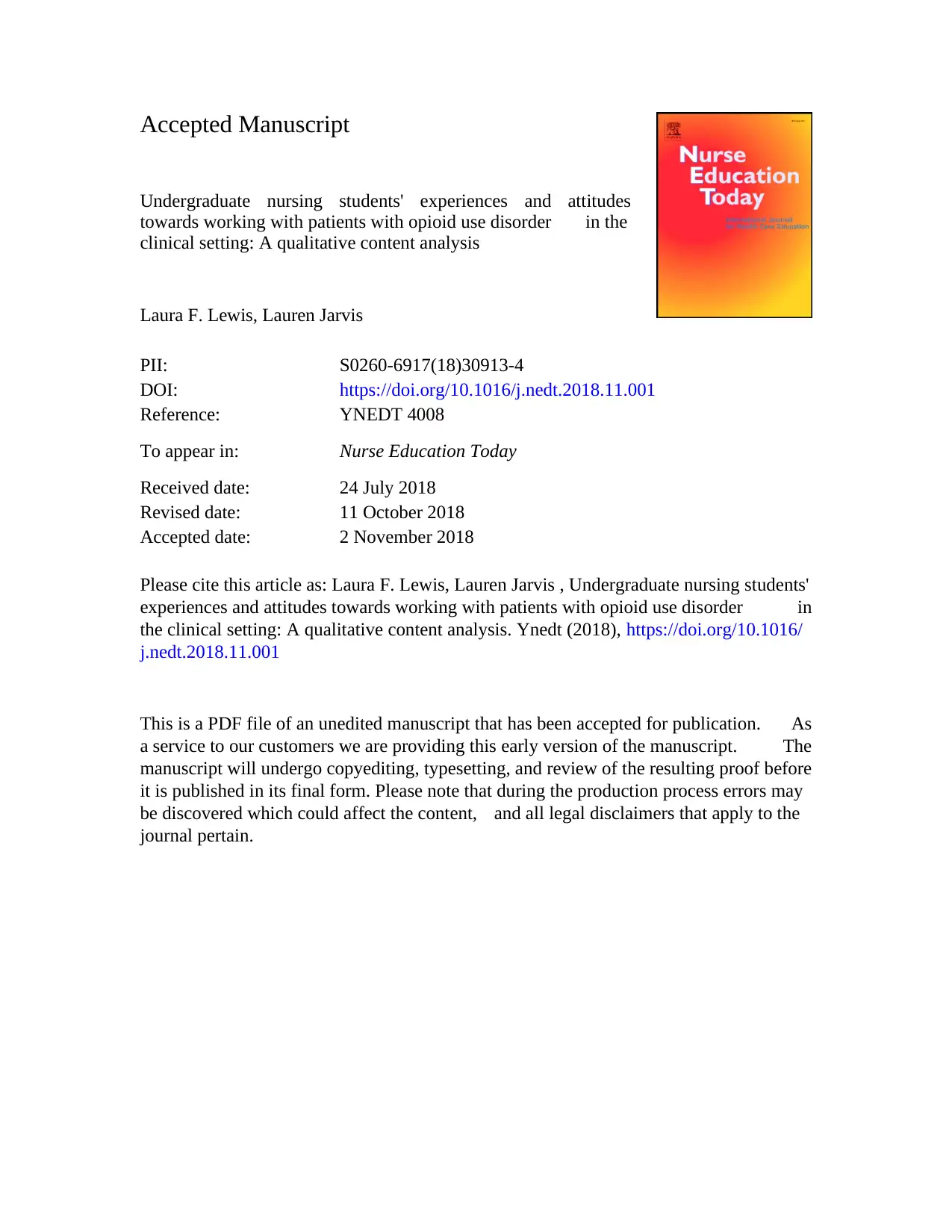
Accepted Manuscript
Undergraduate nursing students' experiences and attitudes
towards working with patients with opioid use disorder in the
clinical setting: A qualitative content analysis
Laura F. Lewis, Lauren Jarvis
PII: S0260-6917(18)30913-4
DOI: https://doi.org/10.1016/j.nedt.2018.11.001
Reference: YNEDT 4008
To appear in: Nurse Education Today
Received date: 24 July 2018
Revised date: 11 October 2018
Accepted date: 2 November 2018
Please cite this article as: Laura F. Lewis, Lauren Jarvis , Undergraduate nursing students'
experiences and attitudes towards working with patients with opioid use disorder in
the clinical setting: A qualitative content analysis. Ynedt (2018), https://doi.org/10.1016/
j.nedt.2018.11.001
This is a PDF file of an unedited manuscript that has been accepted for publication. As
a service to our customers we are providing this early version of the manuscript. The
manuscript will undergo copyediting, typesetting, and review of the resulting proof before
it is published in its final form. Please note that during the production process errors may
be discovered which could affect the content, and all legal disclaimers that apply to the
journal pertain.
Undergraduate nursing students' experiences and attitudes
towards working with patients with opioid use disorder in the
clinical setting: A qualitative content analysis
Laura F. Lewis, Lauren Jarvis
PII: S0260-6917(18)30913-4
DOI: https://doi.org/10.1016/j.nedt.2018.11.001
Reference: YNEDT 4008
To appear in: Nurse Education Today
Received date: 24 July 2018
Revised date: 11 October 2018
Accepted date: 2 November 2018
Please cite this article as: Laura F. Lewis, Lauren Jarvis , Undergraduate nursing students'
experiences and attitudes towards working with patients with opioid use disorder in
the clinical setting: A qualitative content analysis. Ynedt (2018), https://doi.org/10.1016/
j.nedt.2018.11.001
This is a PDF file of an unedited manuscript that has been accepted for publication. As
a service to our customers we are providing this early version of the manuscript. The
manuscript will undergo copyediting, typesetting, and review of the resulting proof before
it is published in its final form. Please note that during the production process errors may
be discovered which could affect the content, and all legal disclaimers that apply to the
journal pertain.
Paraphrase This Document
Need a fresh take? Get an instant paraphrase of this document with our AI Paraphraser

ACCEPTED MANUSCRIPT
Research Paper
UNDERGRADUATE NURSING STUDENTS’ EXPERIENCES AND ATTITUDES TOWARDS WORKING WITH
PATIENTS WITH OPIOID USE DISORDER IN THE CLINICAL SETTING: A QUALITATIVE CONTENT ANALYSIS
Laura F. Lewis, RN, PhD
University of Vermont, USA
Lauren Jarvis, RN, BSN
MedStar Georgetown University Hospital, USA
Corresponding Author:
Laura Lewis
University of Vermont Nursing Department
216 Rowell Building, 106 Carrigan Drive
Burlington, Vermont 05405
Email: laura.lewis@uvm.edu
Phone: 802-656-3601
Acknowledgements:
This work was supported by the University of Vermont Honors College. The authors wish to thank the
participants of this study for their willingness to share their experiences with us.
Contribution Statement:
L.J. conceived of the idea, conducted all interviews, analyzed findings, and drafted a thesis on which this
manuscript was based. L.F.L. supervised the research process, co-analyzed data, and wrote the
manuscript.
Conflict of Interest:
The authors declare that they have no conflicts of interest.
Word Count: 4,996
ACCEPTED MANUSCRIPT
Research Paper
UNDERGRADUATE NURSING STUDENTS’ EXPERIENCES AND ATTITUDES TOWARDS WORKING WITH
PATIENTS WITH OPIOID USE DISORDER IN THE CLINICAL SETTING: A QUALITATIVE CONTENT ANALYSIS
Laura F. Lewis, RN, PhD
University of Vermont, USA
Lauren Jarvis, RN, BSN
MedStar Georgetown University Hospital, USA
Corresponding Author:
Laura Lewis
University of Vermont Nursing Department
216 Rowell Building, 106 Carrigan Drive
Burlington, Vermont 05405
Email: laura.lewis@uvm.edu
Phone: 802-656-3601
Acknowledgements:
This work was supported by the University of Vermont Honors College. The authors wish to thank the
participants of this study for their willingness to share their experiences with us.
Contribution Statement:
L.J. conceived of the idea, conducted all interviews, analyzed findings, and drafted a thesis on which this
manuscript was based. L.F.L. supervised the research process, co-analyzed data, and wrote the
manuscript.
Conflict of Interest:
The authors declare that they have no conflicts of interest.
Word Count: 4,996
ACCEPTED MANUSCRIPT
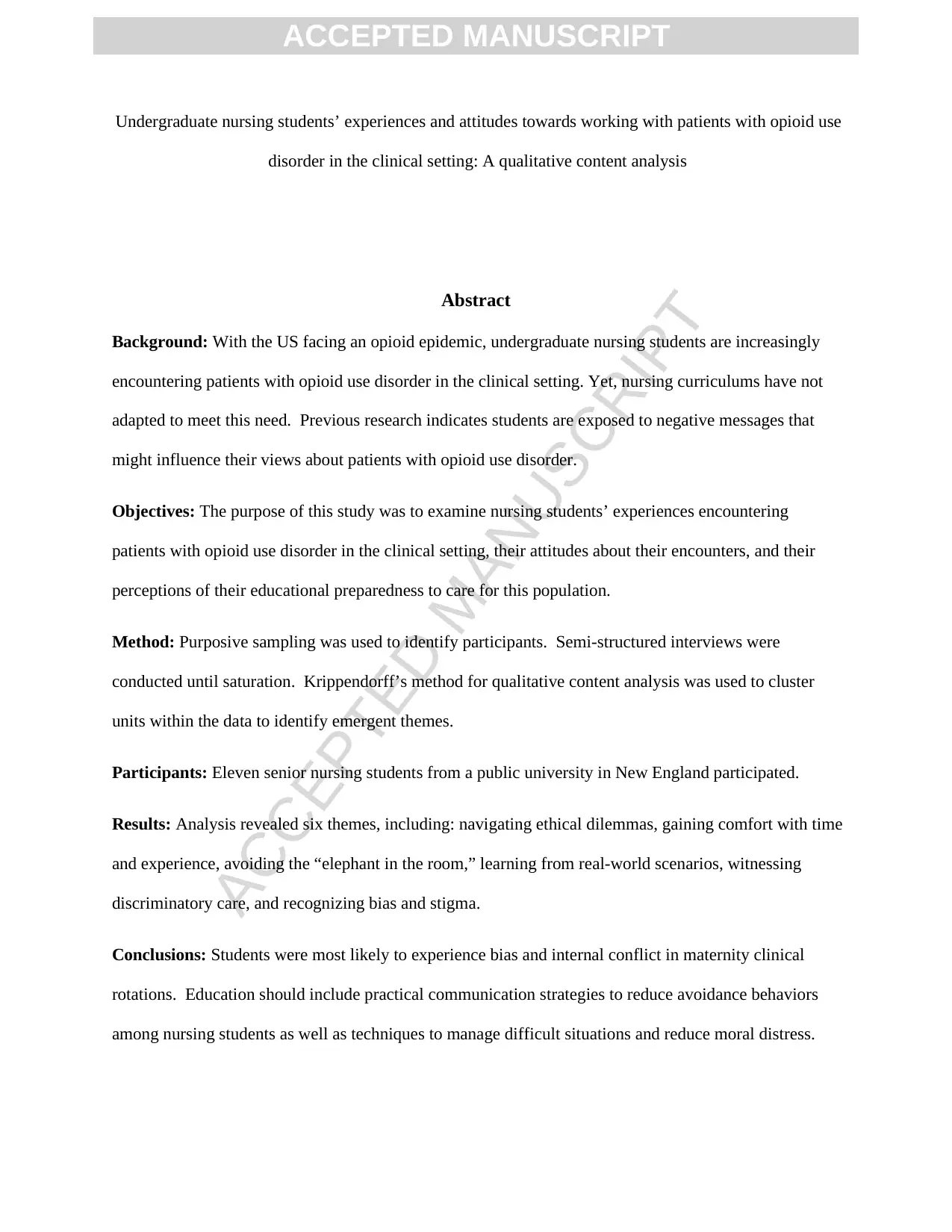
ACCEPTED MANUSCRIPT
Undergraduate nursing students’ experiences and attitudes towards working with patients with opioid use
disorder in the clinical setting: A qualitative content analysis
Abstract
Background: With the US facing an opioid epidemic, undergraduate nursing students are increasingly
encountering patients with opioid use disorder in the clinical setting. Yet, nursing curriculums have not
adapted to meet this need. Previous research indicates students are exposed to negative messages that
might influence their views about patients with opioid use disorder.
Objectives: The purpose of this study was to examine nursing students’ experiences encountering
patients with opioid use disorder in the clinical setting, their attitudes about their encounters, and their
perceptions of their educational preparedness to care for this population.
Method: Purposive sampling was used to identify participants. Semi-structured interviews were
conducted until saturation. Krippendorff’s method for qualitative content analysis was used to cluster
units within the data to identify emergent themes.
Participants: Eleven senior nursing students from a public university in New England participated.
Results: Analysis revealed six themes, including: navigating ethical dilemmas, gaining comfort with time
and experience, avoiding the “elephant in the room,” learning from real-world scenarios, witnessing
discriminatory care, and recognizing bias and stigma.
Conclusions: Students were most likely to experience bias and internal conflict in maternity clinical
rotations. Education should include practical communication strategies to reduce avoidance behaviors
among nursing students as well as techniques to manage difficult situations and reduce moral distress.
ACCEPTED MANUSCRIPT
Undergraduate nursing students’ experiences and attitudes towards working with patients with opioid use
disorder in the clinical setting: A qualitative content analysis
Abstract
Background: With the US facing an opioid epidemic, undergraduate nursing students are increasingly
encountering patients with opioid use disorder in the clinical setting. Yet, nursing curriculums have not
adapted to meet this need. Previous research indicates students are exposed to negative messages that
might influence their views about patients with opioid use disorder.
Objectives: The purpose of this study was to examine nursing students’ experiences encountering
patients with opioid use disorder in the clinical setting, their attitudes about their encounters, and their
perceptions of their educational preparedness to care for this population.
Method: Purposive sampling was used to identify participants. Semi-structured interviews were
conducted until saturation. Krippendorff’s method for qualitative content analysis was used to cluster
units within the data to identify emergent themes.
Participants: Eleven senior nursing students from a public university in New England participated.
Results: Analysis revealed six themes, including: navigating ethical dilemmas, gaining comfort with time
and experience, avoiding the “elephant in the room,” learning from real-world scenarios, witnessing
discriminatory care, and recognizing bias and stigma.
Conclusions: Students were most likely to experience bias and internal conflict in maternity clinical
rotations. Education should include practical communication strategies to reduce avoidance behaviors
among nursing students as well as techniques to manage difficult situations and reduce moral distress.
ACCEPTED MANUSCRIPT
⊘ This is a preview!⊘
Do you want full access?
Subscribe today to unlock all pages.

Trusted by 1+ million students worldwide
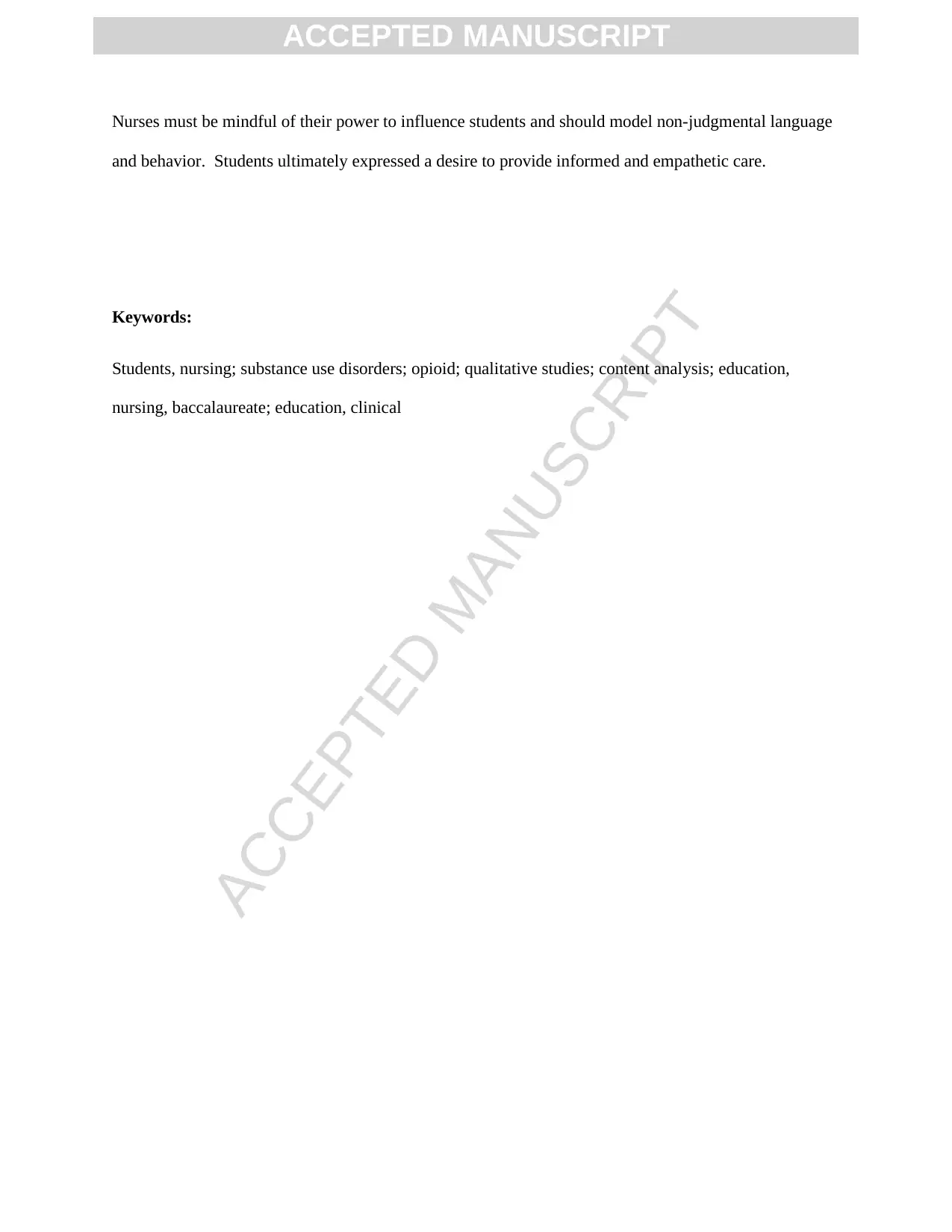
ACCEPTED MANUSCRIPT
Nurses must be mindful of their power to influence students and should model non-judgmental language
and behavior. Students ultimately expressed a desire to provide informed and empathetic care.
Keywords:
Students, nursing; substance use disorders; opioid; qualitative studies; content analysis; education,
nursing, baccalaureate; education, clinical
ACCEPTED MANUSCRIPT
Nurses must be mindful of their power to influence students and should model non-judgmental language
and behavior. Students ultimately expressed a desire to provide informed and empathetic care.
Keywords:
Students, nursing; substance use disorders; opioid; qualitative studies; content analysis; education,
nursing, baccalaureate; education, clinical
ACCEPTED MANUSCRIPT
Paraphrase This Document
Need a fresh take? Get an instant paraphrase of this document with our AI Paraphraser
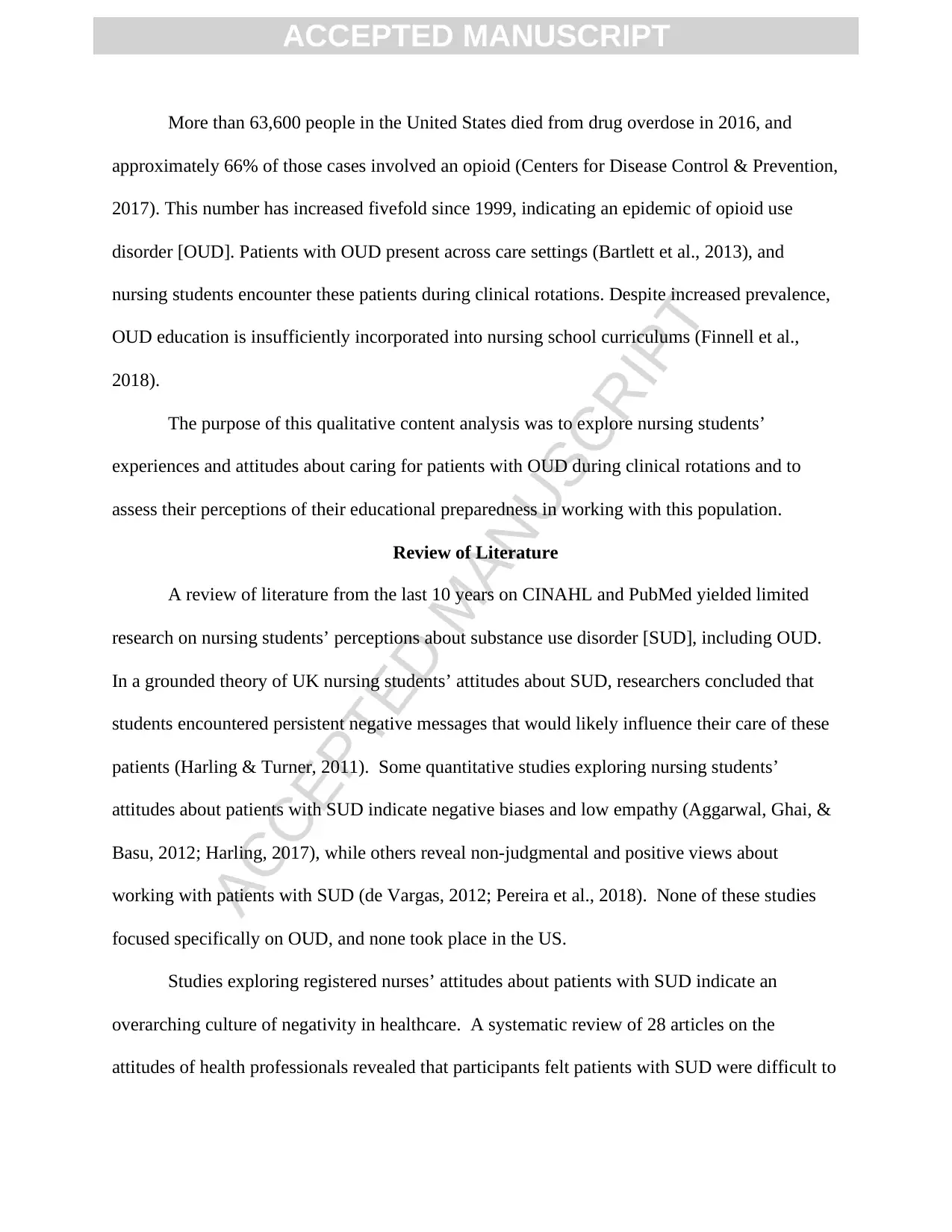
ACCEPTED MANUSCRIPT
More than 63,600 people in the United States died from drug overdose in 2016, and
approximately 66% of those cases involved an opioid (Centers for Disease Control & Prevention,
2017). This number has increased fivefold since 1999, indicating an epidemic of opioid use
disorder [OUD]. Patients with OUD present across care settings (Bartlett et al., 2013), and
nursing students encounter these patients during clinical rotations. Despite increased prevalence,
OUD education is insufficiently incorporated into nursing school curriculums (Finnell et al.,
2018).
The purpose of this qualitative content analysis was to explore nursing students’
experiences and attitudes about caring for patients with OUD during clinical rotations and to
assess their perceptions of their educational preparedness in working with this population.
Review of Literature
A review of literature from the last 10 years on CINAHL and PubMed yielded limited
research on nursing students’ perceptions about substance use disorder [SUD], including OUD.
In a grounded theory of UK nursing students’ attitudes about SUD, researchers concluded that
students encountered persistent negative messages that would likely influence their care of these
patients (Harling & Turner, 2011). Some quantitative studies exploring nursing students’
attitudes about patients with SUD indicate negative biases and low empathy (Aggarwal, Ghai, &
Basu, 2012; Harling, 2017), while others reveal non-judgmental and positive views about
working with patients with SUD (de Vargas, 2012; Pereira et al., 2018). None of these studies
focused specifically on OUD, and none took place in the US.
Studies exploring registered nurses’ attitudes about patients with SUD indicate an
overarching culture of negativity in healthcare. A systematic review of 28 articles on the
attitudes of health professionals revealed that participants felt patients with SUD were difficult to
ACCEPTED MANUSCRIPT
More than 63,600 people in the United States died from drug overdose in 2016, and
approximately 66% of those cases involved an opioid (Centers for Disease Control & Prevention,
2017). This number has increased fivefold since 1999, indicating an epidemic of opioid use
disorder [OUD]. Patients with OUD present across care settings (Bartlett et al., 2013), and
nursing students encounter these patients during clinical rotations. Despite increased prevalence,
OUD education is insufficiently incorporated into nursing school curriculums (Finnell et al.,
2018).
The purpose of this qualitative content analysis was to explore nursing students’
experiences and attitudes about caring for patients with OUD during clinical rotations and to
assess their perceptions of their educational preparedness in working with this population.
Review of Literature
A review of literature from the last 10 years on CINAHL and PubMed yielded limited
research on nursing students’ perceptions about substance use disorder [SUD], including OUD.
In a grounded theory of UK nursing students’ attitudes about SUD, researchers concluded that
students encountered persistent negative messages that would likely influence their care of these
patients (Harling & Turner, 2011). Some quantitative studies exploring nursing students’
attitudes about patients with SUD indicate negative biases and low empathy (Aggarwal, Ghai, &
Basu, 2012; Harling, 2017), while others reveal non-judgmental and positive views about
working with patients with SUD (de Vargas, 2012; Pereira et al., 2018). None of these studies
focused specifically on OUD, and none took place in the US.
Studies exploring registered nurses’ attitudes about patients with SUD indicate an
overarching culture of negativity in healthcare. A systematic review of 28 articles on the
attitudes of health professionals revealed that participants felt patients with SUD were difficult to
ACCEPTED MANUSCRIPT
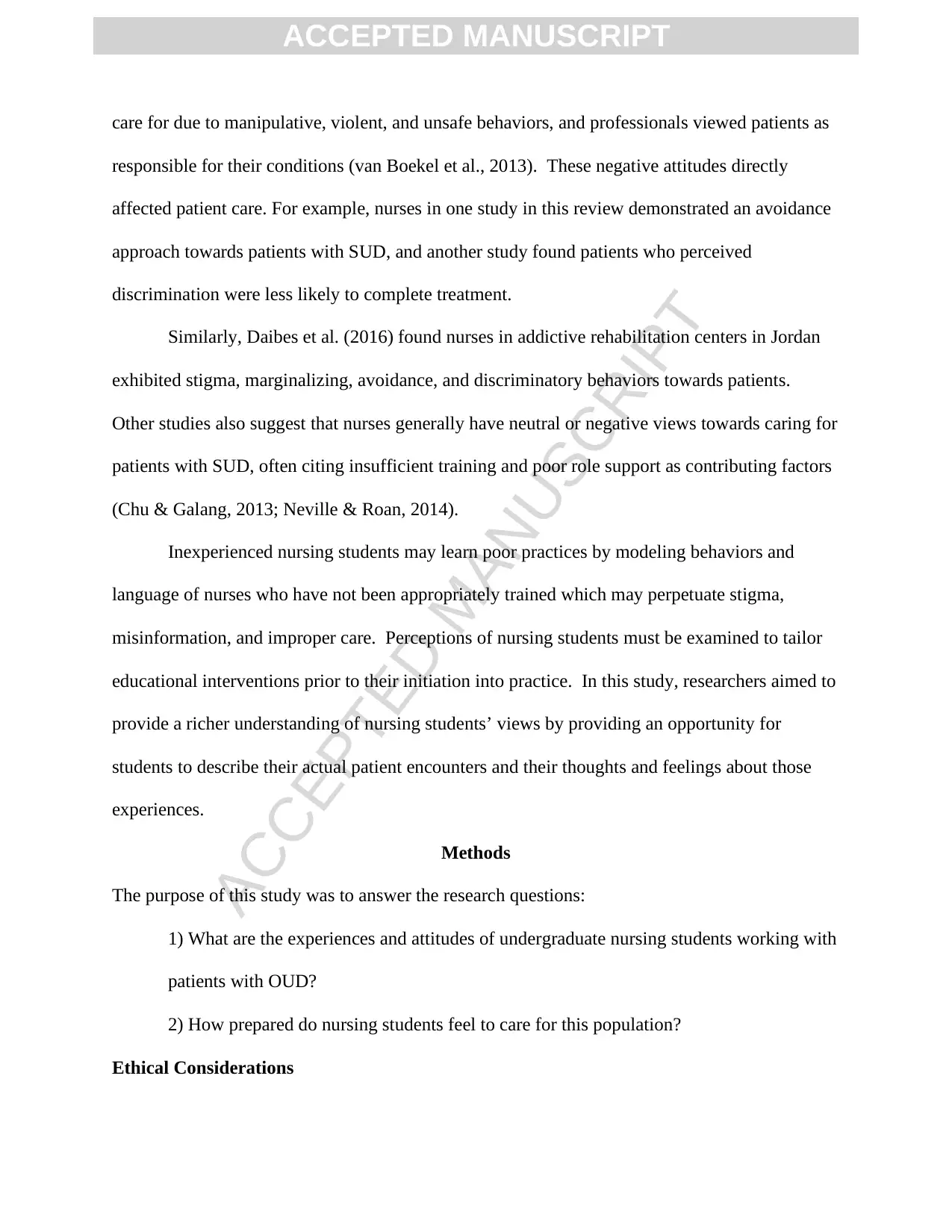
ACCEPTED MANUSCRIPT
care for due to manipulative, violent, and unsafe behaviors, and professionals viewed patients as
responsible for their conditions (van Boekel et al., 2013). These negative attitudes directly
affected patient care. For example, nurses in one study in this review demonstrated an avoidance
approach towards patients with SUD, and another study found patients who perceived
discrimination were less likely to complete treatment.
Similarly, Daibes et al. (2016) found nurses in addictive rehabilitation centers in Jordan
exhibited stigma, marginalizing, avoidance, and discriminatory behaviors towards patients.
Other studies also suggest that nurses generally have neutral or negative views towards caring for
patients with SUD, often citing insufficient training and poor role support as contributing factors
(Chu & Galang, 2013; Neville & Roan, 2014).
Inexperienced nursing students may learn poor practices by modeling behaviors and
language of nurses who have not been appropriately trained which may perpetuate stigma,
misinformation, and improper care. Perceptions of nursing students must be examined to tailor
educational interventions prior to their initiation into practice. In this study, researchers aimed to
provide a richer understanding of nursing students’ views by providing an opportunity for
students to describe their actual patient encounters and their thoughts and feelings about those
experiences.
Methods
The purpose of this study was to answer the research questions:
1) What are the experiences and attitudes of undergraduate nursing students working with
patients with OUD?
2) How prepared do nursing students feel to care for this population?
Ethical Considerations
ACCEPTED MANUSCRIPT
care for due to manipulative, violent, and unsafe behaviors, and professionals viewed patients as
responsible for their conditions (van Boekel et al., 2013). These negative attitudes directly
affected patient care. For example, nurses in one study in this review demonstrated an avoidance
approach towards patients with SUD, and another study found patients who perceived
discrimination were less likely to complete treatment.
Similarly, Daibes et al. (2016) found nurses in addictive rehabilitation centers in Jordan
exhibited stigma, marginalizing, avoidance, and discriminatory behaviors towards patients.
Other studies also suggest that nurses generally have neutral or negative views towards caring for
patients with SUD, often citing insufficient training and poor role support as contributing factors
(Chu & Galang, 2013; Neville & Roan, 2014).
Inexperienced nursing students may learn poor practices by modeling behaviors and
language of nurses who have not been appropriately trained which may perpetuate stigma,
misinformation, and improper care. Perceptions of nursing students must be examined to tailor
educational interventions prior to their initiation into practice. In this study, researchers aimed to
provide a richer understanding of nursing students’ views by providing an opportunity for
students to describe their actual patient encounters and their thoughts and feelings about those
experiences.
Methods
The purpose of this study was to answer the research questions:
1) What are the experiences and attitudes of undergraduate nursing students working with
patients with OUD?
2) How prepared do nursing students feel to care for this population?
Ethical Considerations
ACCEPTED MANUSCRIPT
⊘ This is a preview!⊘
Do you want full access?
Subscribe today to unlock all pages.

Trusted by 1+ million students worldwide
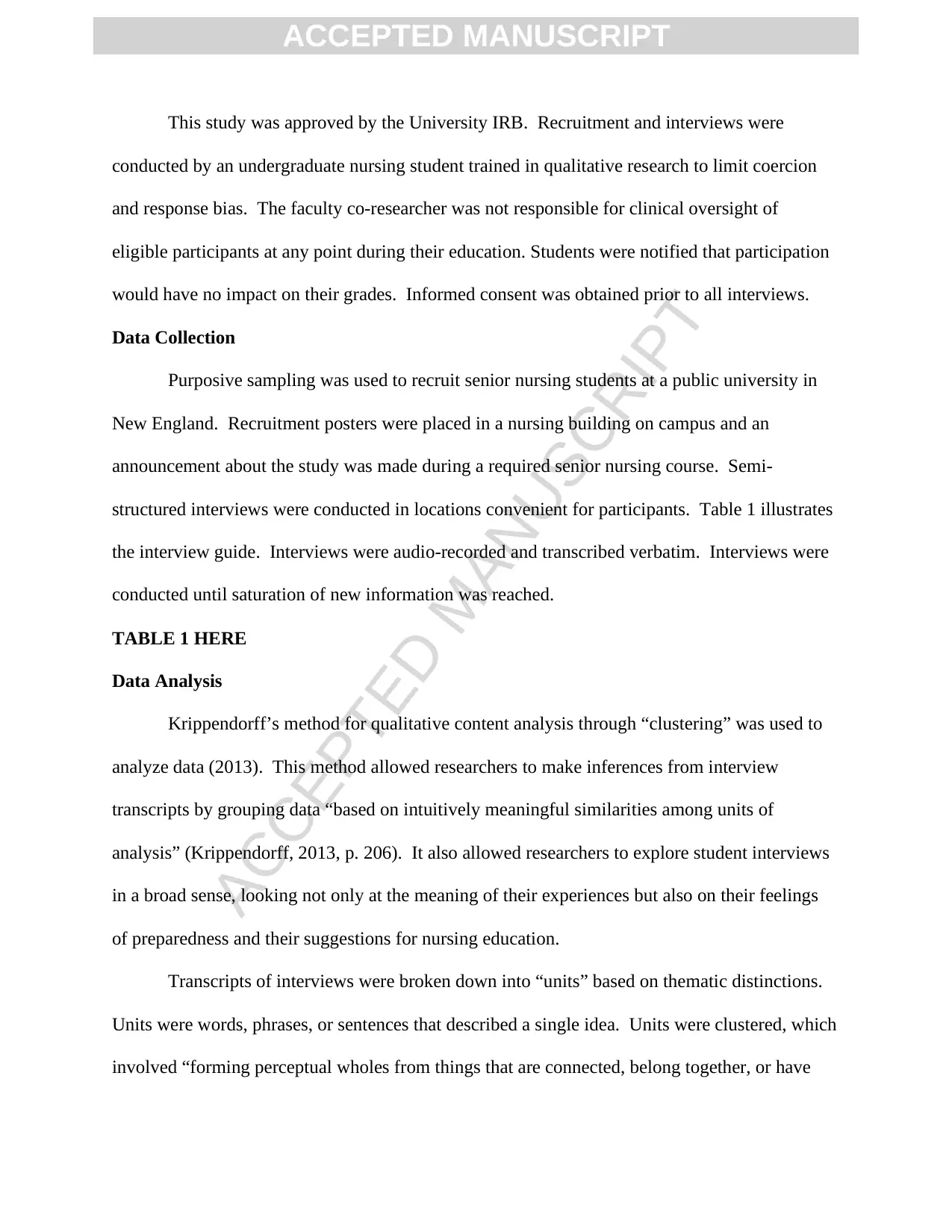
ACCEPTED MANUSCRIPT
This study was approved by the University IRB. Recruitment and interviews were
conducted by an undergraduate nursing student trained in qualitative research to limit coercion
and response bias. The faculty co-researcher was not responsible for clinical oversight of
eligible participants at any point during their education. Students were notified that participation
would have no impact on their grades. Informed consent was obtained prior to all interviews.
Data Collection
Purposive sampling was used to recruit senior nursing students at a public university in
New England. Recruitment posters were placed in a nursing building on campus and an
announcement about the study was made during a required senior nursing course. Semi-
structured interviews were conducted in locations convenient for participants. Table 1 illustrates
the interview guide. Interviews were audio-recorded and transcribed verbatim. Interviews were
conducted until saturation of new information was reached.
TABLE 1 HERE
Data Analysis
Krippendorff’s method for qualitative content analysis through “clustering” was used to
analyze data (2013). This method allowed researchers to make inferences from interview
transcripts by grouping data “based on intuitively meaningful similarities among units of
analysis” (Krippendorff, 2013, p. 206). It also allowed researchers to explore student interviews
in a broad sense, looking not only at the meaning of their experiences but also on their feelings
of preparedness and their suggestions for nursing education.
Transcripts of interviews were broken down into “units” based on thematic distinctions.
Units were words, phrases, or sentences that described a single idea. Units were clustered, which
involved “forming perceptual wholes from things that are connected, belong together, or have
ACCEPTED MANUSCRIPT
This study was approved by the University IRB. Recruitment and interviews were
conducted by an undergraduate nursing student trained in qualitative research to limit coercion
and response bias. The faculty co-researcher was not responsible for clinical oversight of
eligible participants at any point during their education. Students were notified that participation
would have no impact on their grades. Informed consent was obtained prior to all interviews.
Data Collection
Purposive sampling was used to recruit senior nursing students at a public university in
New England. Recruitment posters were placed in a nursing building on campus and an
announcement about the study was made during a required senior nursing course. Semi-
structured interviews were conducted in locations convenient for participants. Table 1 illustrates
the interview guide. Interviews were audio-recorded and transcribed verbatim. Interviews were
conducted until saturation of new information was reached.
TABLE 1 HERE
Data Analysis
Krippendorff’s method for qualitative content analysis through “clustering” was used to
analyze data (2013). This method allowed researchers to make inferences from interview
transcripts by grouping data “based on intuitively meaningful similarities among units of
analysis” (Krippendorff, 2013, p. 206). It also allowed researchers to explore student interviews
in a broad sense, looking not only at the meaning of their experiences but also on their feelings
of preparedness and their suggestions for nursing education.
Transcripts of interviews were broken down into “units” based on thematic distinctions.
Units were words, phrases, or sentences that described a single idea. Units were clustered, which
involved “forming perceptual wholes from things that are connected, belong together, or have
ACCEPTED MANUSCRIPT
Paraphrase This Document
Need a fresh take? Get an instant paraphrase of this document with our AI Paraphraser
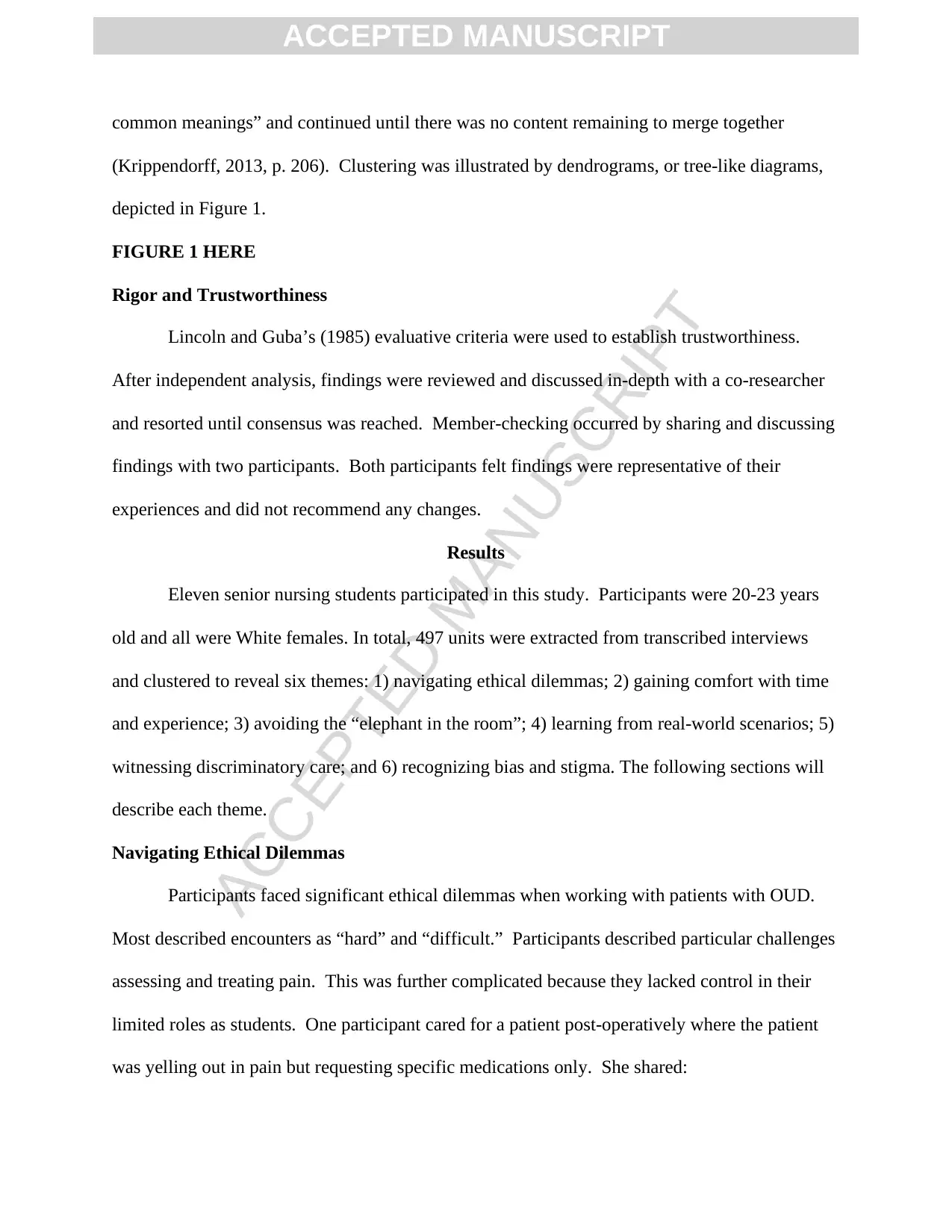
ACCEPTED MANUSCRIPT
common meanings” and continued until there was no content remaining to merge together
(Krippendorff, 2013, p. 206). Clustering was illustrated by dendrograms, or tree-like diagrams,
depicted in Figure 1.
FIGURE 1 HERE
Rigor and Trustworthiness
Lincoln and Guba’s (1985) evaluative criteria were used to establish trustworthiness.
After independent analysis, findings were reviewed and discussed in-depth with a co-researcher
and resorted until consensus was reached. Member-checking occurred by sharing and discussing
findings with two participants. Both participants felt findings were representative of their
experiences and did not recommend any changes.
Results
Eleven senior nursing students participated in this study. Participants were 20-23 years
old and all were White females. In total, 497 units were extracted from transcribed interviews
and clustered to reveal six themes: 1) navigating ethical dilemmas; 2) gaining comfort with time
and experience; 3) avoiding the “elephant in the room”; 4) learning from real-world scenarios; 5)
witnessing discriminatory care; and 6) recognizing bias and stigma. The following sections will
describe each theme.
Navigating Ethical Dilemmas
Participants faced significant ethical dilemmas when working with patients with OUD.
Most described encounters as “hard” and “difficult.” Participants described particular challenges
assessing and treating pain. This was further complicated because they lacked control in their
limited roles as students. One participant cared for a patient post-operatively where the patient
was yelling out in pain but requesting specific medications only. She shared:
ACCEPTED MANUSCRIPT
common meanings” and continued until there was no content remaining to merge together
(Krippendorff, 2013, p. 206). Clustering was illustrated by dendrograms, or tree-like diagrams,
depicted in Figure 1.
FIGURE 1 HERE
Rigor and Trustworthiness
Lincoln and Guba’s (1985) evaluative criteria were used to establish trustworthiness.
After independent analysis, findings were reviewed and discussed in-depth with a co-researcher
and resorted until consensus was reached. Member-checking occurred by sharing and discussing
findings with two participants. Both participants felt findings were representative of their
experiences and did not recommend any changes.
Results
Eleven senior nursing students participated in this study. Participants were 20-23 years
old and all were White females. In total, 497 units were extracted from transcribed interviews
and clustered to reveal six themes: 1) navigating ethical dilemmas; 2) gaining comfort with time
and experience; 3) avoiding the “elephant in the room”; 4) learning from real-world scenarios; 5)
witnessing discriminatory care; and 6) recognizing bias and stigma. The following sections will
describe each theme.
Navigating Ethical Dilemmas
Participants faced significant ethical dilemmas when working with patients with OUD.
Most described encounters as “hard” and “difficult.” Participants described particular challenges
assessing and treating pain. This was further complicated because they lacked control in their
limited roles as students. One participant cared for a patient post-operatively where the patient
was yelling out in pain but requesting specific medications only. She shared:
ACCEPTED MANUSCRIPT
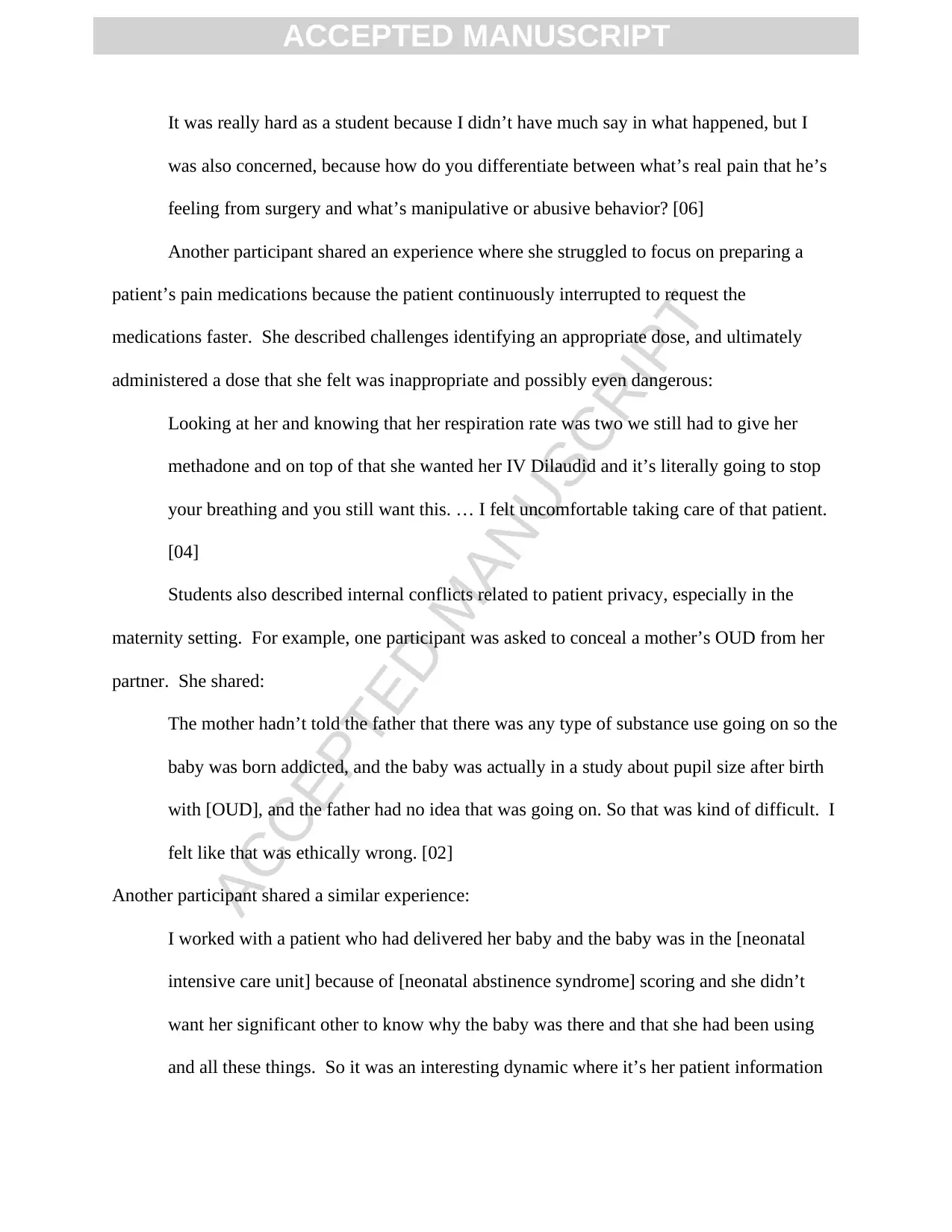
ACCEPTED MANUSCRIPT
It was really hard as a student because I didn’t have much say in what happened, but I
was also concerned, because how do you differentiate between what’s real pain that he’s
feeling from surgery and what’s manipulative or abusive behavior? [06]
Another participant shared an experience where she struggled to focus on preparing a
patient’s pain medications because the patient continuously interrupted to request the
medications faster. She described challenges identifying an appropriate dose, and ultimately
administered a dose that she felt was inappropriate and possibly even dangerous:
Looking at her and knowing that her respiration rate was two we still had to give her
methadone and on top of that she wanted her IV Dilaudid and it’s literally going to stop
your breathing and you still want this. … I felt uncomfortable taking care of that patient.
[04]
Students also described internal conflicts related to patient privacy, especially in the
maternity setting. For example, one participant was asked to conceal a mother’s OUD from her
partner. She shared:
The mother hadn’t told the father that there was any type of substance use going on so the
baby was born addicted, and the baby was actually in a study about pupil size after birth
with [OUD], and the father had no idea that was going on. So that was kind of difficult. I
felt like that was ethically wrong. [02]
Another participant shared a similar experience:
I worked with a patient who had delivered her baby and the baby was in the [neonatal
intensive care unit] because of [neonatal abstinence syndrome] scoring and she didn’t
want her significant other to know why the baby was there and that she had been using
and all these things. So it was an interesting dynamic where it’s her patient information
ACCEPTED MANUSCRIPT
It was really hard as a student because I didn’t have much say in what happened, but I
was also concerned, because how do you differentiate between what’s real pain that he’s
feeling from surgery and what’s manipulative or abusive behavior? [06]
Another participant shared an experience where she struggled to focus on preparing a
patient’s pain medications because the patient continuously interrupted to request the
medications faster. She described challenges identifying an appropriate dose, and ultimately
administered a dose that she felt was inappropriate and possibly even dangerous:
Looking at her and knowing that her respiration rate was two we still had to give her
methadone and on top of that she wanted her IV Dilaudid and it’s literally going to stop
your breathing and you still want this. … I felt uncomfortable taking care of that patient.
[04]
Students also described internal conflicts related to patient privacy, especially in the
maternity setting. For example, one participant was asked to conceal a mother’s OUD from her
partner. She shared:
The mother hadn’t told the father that there was any type of substance use going on so the
baby was born addicted, and the baby was actually in a study about pupil size after birth
with [OUD], and the father had no idea that was going on. So that was kind of difficult. I
felt like that was ethically wrong. [02]
Another participant shared a similar experience:
I worked with a patient who had delivered her baby and the baby was in the [neonatal
intensive care unit] because of [neonatal abstinence syndrome] scoring and she didn’t
want her significant other to know why the baby was there and that she had been using
and all these things. So it was an interesting dynamic where it’s her patient information
ACCEPTED MANUSCRIPT
⊘ This is a preview!⊘
Do you want full access?
Subscribe today to unlock all pages.

Trusted by 1+ million students worldwide
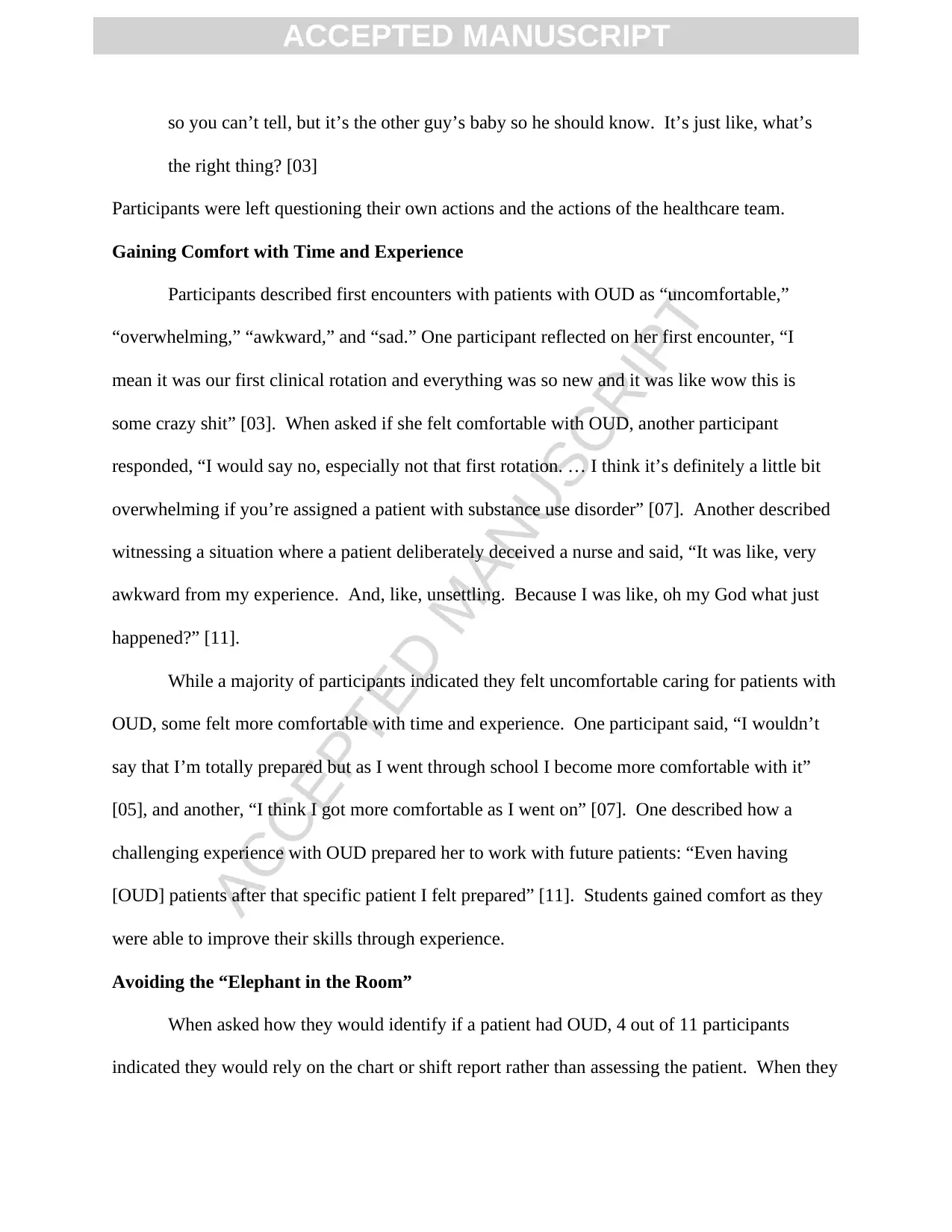
ACCEPTED MANUSCRIPT
so you can’t tell, but it’s the other guy’s baby so he should know. It’s just like, what’s
the right thing? [03]
Participants were left questioning their own actions and the actions of the healthcare team.
Gaining Comfort with Time and Experience
Participants described first encounters with patients with OUD as “uncomfortable,”
“overwhelming,” “awkward,” and “sad.” One participant reflected on her first encounter, “I
mean it was our first clinical rotation and everything was so new and it was like wow this is
some crazy shit” [03]. When asked if she felt comfortable with OUD, another participant
responded, “I would say no, especially not that first rotation. … I think it’s definitely a little bit
overwhelming if you’re assigned a patient with substance use disorder” [07]. Another described
witnessing a situation where a patient deliberately deceived a nurse and said, “It was like, very
awkward from my experience. And, like, unsettling. Because I was like, oh my God what just
happened?” [11].
While a majority of participants indicated they felt uncomfortable caring for patients with
OUD, some felt more comfortable with time and experience. One participant said, “I wouldn’t
say that I’m totally prepared but as I went through school I become more comfortable with it”
[05], and another, “I think I got more comfortable as I went on” [07]. One described how a
challenging experience with OUD prepared her to work with future patients: “Even having
[OUD] patients after that specific patient I felt prepared” [11]. Students gained comfort as they
were able to improve their skills through experience.
Avoiding the “Elephant in the Room”
When asked how they would identify if a patient had OUD, 4 out of 11 participants
indicated they would rely on the chart or shift report rather than assessing the patient. When they
ACCEPTED MANUSCRIPT
so you can’t tell, but it’s the other guy’s baby so he should know. It’s just like, what’s
the right thing? [03]
Participants were left questioning their own actions and the actions of the healthcare team.
Gaining Comfort with Time and Experience
Participants described first encounters with patients with OUD as “uncomfortable,”
“overwhelming,” “awkward,” and “sad.” One participant reflected on her first encounter, “I
mean it was our first clinical rotation and everything was so new and it was like wow this is
some crazy shit” [03]. When asked if she felt comfortable with OUD, another participant
responded, “I would say no, especially not that first rotation. … I think it’s definitely a little bit
overwhelming if you’re assigned a patient with substance use disorder” [07]. Another described
witnessing a situation where a patient deliberately deceived a nurse and said, “It was like, very
awkward from my experience. And, like, unsettling. Because I was like, oh my God what just
happened?” [11].
While a majority of participants indicated they felt uncomfortable caring for patients with
OUD, some felt more comfortable with time and experience. One participant said, “I wouldn’t
say that I’m totally prepared but as I went through school I become more comfortable with it”
[05], and another, “I think I got more comfortable as I went on” [07]. One described how a
challenging experience with OUD prepared her to work with future patients: “Even having
[OUD] patients after that specific patient I felt prepared” [11]. Students gained comfort as they
were able to improve their skills through experience.
Avoiding the “Elephant in the Room”
When asked how they would identify if a patient had OUD, 4 out of 11 participants
indicated they would rely on the chart or shift report rather than assessing the patient. When they
ACCEPTED MANUSCRIPT
Paraphrase This Document
Need a fresh take? Get an instant paraphrase of this document with our AI Paraphraser
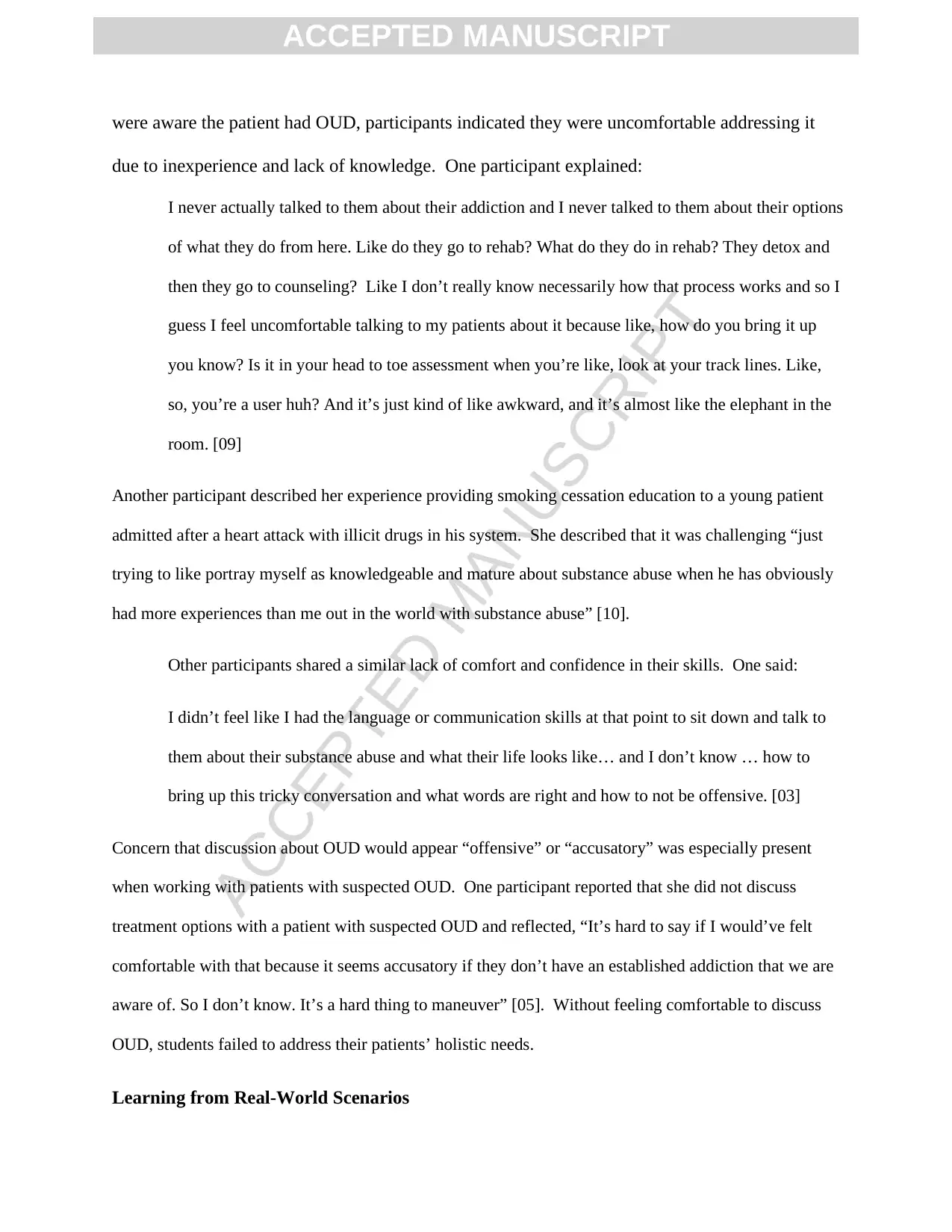
ACCEPTED MANUSCRIPT
were aware the patient had OUD, participants indicated they were uncomfortable addressing it
due to inexperience and lack of knowledge. One participant explained:
I never actually talked to them about their addiction and I never talked to them about their options
of what they do from here. Like do they go to rehab? What do they do in rehab? They detox and
then they go to counseling? Like I don’t really know necessarily how that process works and so I
guess I feel uncomfortable talking to my patients about it because like, how do you bring it up
you know? Is it in your head to toe assessment when you’re like, look at your track lines. Like,
so, you’re a user huh? And it’s just kind of like awkward, and it’s almost like the elephant in the
room. [09]
Another participant described her experience providing smoking cessation education to a young patient
admitted after a heart attack with illicit drugs in his system. She described that it was challenging “just
trying to like portray myself as knowledgeable and mature about substance abuse when he has obviously
had more experiences than me out in the world with substance abuse” [10].
Other participants shared a similar lack of comfort and confidence in their skills. One said:
I didn’t feel like I had the language or communication skills at that point to sit down and talk to
them about their substance abuse and what their life looks like… and I don’t know … how to
bring up this tricky conversation and what words are right and how to not be offensive. [03]
Concern that discussion about OUD would appear “offensive” or “accusatory” was especially present
when working with patients with suspected OUD. One participant reported that she did not discuss
treatment options with a patient with suspected OUD and reflected, “It’s hard to say if I would’ve felt
comfortable with that because it seems accusatory if they don’t have an established addiction that we are
aware of. So I don’t know. It’s a hard thing to maneuver” [05]. Without feeling comfortable to discuss
OUD, students failed to address their patients’ holistic needs.
Learning from Real-World Scenarios
ACCEPTED MANUSCRIPT
were aware the patient had OUD, participants indicated they were uncomfortable addressing it
due to inexperience and lack of knowledge. One participant explained:
I never actually talked to them about their addiction and I never talked to them about their options
of what they do from here. Like do they go to rehab? What do they do in rehab? They detox and
then they go to counseling? Like I don’t really know necessarily how that process works and so I
guess I feel uncomfortable talking to my patients about it because like, how do you bring it up
you know? Is it in your head to toe assessment when you’re like, look at your track lines. Like,
so, you’re a user huh? And it’s just kind of like awkward, and it’s almost like the elephant in the
room. [09]
Another participant described her experience providing smoking cessation education to a young patient
admitted after a heart attack with illicit drugs in his system. She described that it was challenging “just
trying to like portray myself as knowledgeable and mature about substance abuse when he has obviously
had more experiences than me out in the world with substance abuse” [10].
Other participants shared a similar lack of comfort and confidence in their skills. One said:
I didn’t feel like I had the language or communication skills at that point to sit down and talk to
them about their substance abuse and what their life looks like… and I don’t know … how to
bring up this tricky conversation and what words are right and how to not be offensive. [03]
Concern that discussion about OUD would appear “offensive” or “accusatory” was especially present
when working with patients with suspected OUD. One participant reported that she did not discuss
treatment options with a patient with suspected OUD and reflected, “It’s hard to say if I would’ve felt
comfortable with that because it seems accusatory if they don’t have an established addiction that we are
aware of. So I don’t know. It’s a hard thing to maneuver” [05]. Without feeling comfortable to discuss
OUD, students failed to address their patients’ holistic needs.
Learning from Real-World Scenarios
ACCEPTED MANUSCRIPT
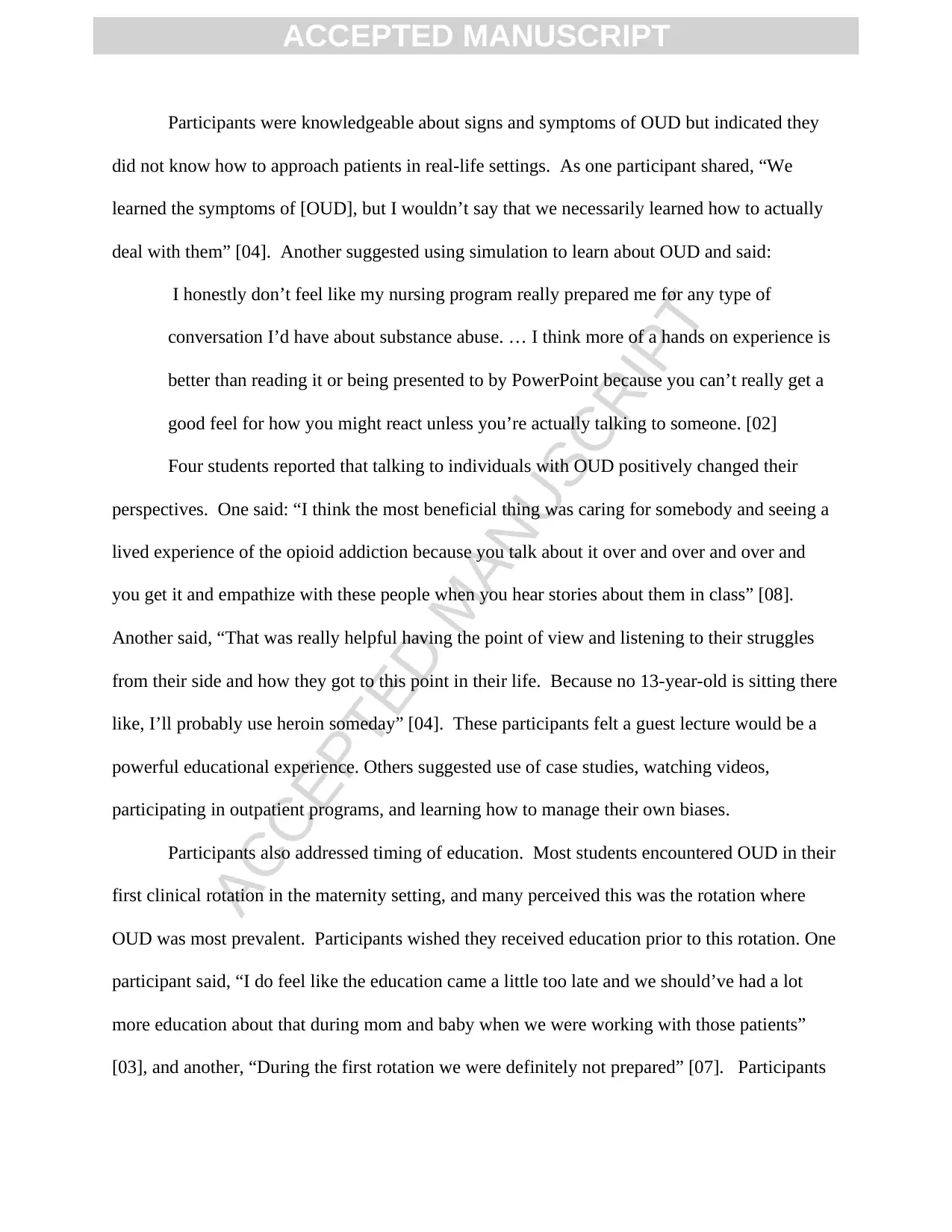
ACCEPTED MANUSCRIPT
Participants were knowledgeable about signs and symptoms of OUD but indicated they
did not know how to approach patients in real-life settings. As one participant shared, “We
learned the symptoms of [OUD], but I wouldn’t say that we necessarily learned how to actually
deal with them” [04]. Another suggested using simulation to learn about OUD and said:
I honestly don’t feel like my nursing program really prepared me for any type of
conversation I’d have about substance abuse. … I think more of a hands on experience is
better than reading it or being presented to by PowerPoint because you can’t really get a
good feel for how you might react unless you’re actually talking to someone. [02]
Four students reported that talking to individuals with OUD positively changed their
perspectives. One said: “I think the most beneficial thing was caring for somebody and seeing a
lived experience of the opioid addiction because you talk about it over and over and over and
you get it and empathize with these people when you hear stories about them in class” [08].
Another said, “That was really helpful having the point of view and listening to their struggles
from their side and how they got to this point in their life. Because no 13-year-old is sitting there
like, I’ll probably use heroin someday” [04]. These participants felt a guest lecture would be a
powerful educational experience. Others suggested use of case studies, watching videos,
participating in outpatient programs, and learning how to manage their own biases.
Participants also addressed timing of education. Most students encountered OUD in their
first clinical rotation in the maternity setting, and many perceived this was the rotation where
OUD was most prevalent. Participants wished they received education prior to this rotation. One
participant said, “I do feel like the education came a little too late and we should’ve had a lot
more education about that during mom and baby when we were working with those patients”
[03], and another, “During the first rotation we were definitely not prepared” [07]. Participants
ACCEPTED MANUSCRIPT
Participants were knowledgeable about signs and symptoms of OUD but indicated they
did not know how to approach patients in real-life settings. As one participant shared, “We
learned the symptoms of [OUD], but I wouldn’t say that we necessarily learned how to actually
deal with them” [04]. Another suggested using simulation to learn about OUD and said:
I honestly don’t feel like my nursing program really prepared me for any type of
conversation I’d have about substance abuse. … I think more of a hands on experience is
better than reading it or being presented to by PowerPoint because you can’t really get a
good feel for how you might react unless you’re actually talking to someone. [02]
Four students reported that talking to individuals with OUD positively changed their
perspectives. One said: “I think the most beneficial thing was caring for somebody and seeing a
lived experience of the opioid addiction because you talk about it over and over and over and
you get it and empathize with these people when you hear stories about them in class” [08].
Another said, “That was really helpful having the point of view and listening to their struggles
from their side and how they got to this point in their life. Because no 13-year-old is sitting there
like, I’ll probably use heroin someday” [04]. These participants felt a guest lecture would be a
powerful educational experience. Others suggested use of case studies, watching videos,
participating in outpatient programs, and learning how to manage their own biases.
Participants also addressed timing of education. Most students encountered OUD in their
first clinical rotation in the maternity setting, and many perceived this was the rotation where
OUD was most prevalent. Participants wished they received education prior to this rotation. One
participant said, “I do feel like the education came a little too late and we should’ve had a lot
more education about that during mom and baby when we were working with those patients”
[03], and another, “During the first rotation we were definitely not prepared” [07]. Participants
ACCEPTED MANUSCRIPT
⊘ This is a preview!⊘
Do you want full access?
Subscribe today to unlock all pages.

Trusted by 1+ million students worldwide
1 out of 24
Your All-in-One AI-Powered Toolkit for Academic Success.
+13062052269
info@desklib.com
Available 24*7 on WhatsApp / Email
![[object Object]](/_next/static/media/star-bottom.7253800d.svg)
Unlock your academic potential
Copyright © 2020–2025 A2Z Services. All Rights Reserved. Developed and managed by ZUCOL.
